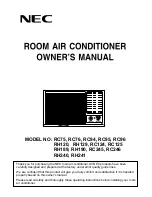
En-11
6.6.3. External output terminal
You can detect the operation condition of outdoor unit and the abnormal situation of both
indoor and outdoor unit.
Wiring method and specifications
Error status
This output indicates the outdoor unit and
connected indoor unit's “Normal” or “Error”
status.
Operation status
This output indicates the outdoor unit's
“Operation” status.
Connector
Output
voltage
Status
Output 1
CN136
(Black)
0 V
Normal
DC 12-24 V
*5
Error
Output 2
CN137
(Blue)
0 V
Stop
DC 12-24 V
*5
Operation
P.C.B
*7
*5
*6
CN136 (Black) or
CN137 (Blue)
DC power supply
(External) 12-24 V
Connected load (Operation Indica-
tor or Error Indicator)
Connected unit
*5: Provide a DC 12 to 24 V power supply.
Select a power supply capacity with an ample surplus for the connected load.
*6: The allowable current is 30 mA or less.
Provide a load resistance such that the current becomes 30 mA or less.
*7: Polarity is [+] for pin 1 and [-] for pin 2. Connect correctly.
Do not impress a voltage exceeding 24 V across pins 1-2.
* A twisted pair cable (22 AWG (0.33 mm²)) should be used. Maximum length of cable is
492 ft (150 m).
* Use an external input and output cable with appropriate external dimension, depending
on the number of cables to be installed.
6.6.4. Base heater terminal
This is the output signal for base heater. Output signal ON, when the outdoor temperature
goes down below 32°F (2°C), and signal OFF at the outdoor temperature 39°F (4°C).
Voltage:
power supply input voltage
cable
(0.82 mm² (18 AWG))
P.C.B.
Base heater *9
CN115
(Black)
*8
*8: Connect to pin 1 and pin 3. No connection pin 2 and pin 4.
*9: The allowable current is 1 A or less.
7. FIELD
SETTING
CAUTION
Discharge the static electricity from your body before setting up the DIP switches.
Never touch the terminals or the patterns on the parts that are mounted on the PC
board.
7.1. Field setting switches
Remove the service panel of the outdoor unit and the cover of the electrical component
box to access the PC board of the outdoor unit.
PC board switches for various settings and LED displays are shown in the figure.
7.2. DIP switch setting
7.2.1. List of Settings
SET 5 must be set for the DIP switch.
Configure the settings before turn-
ing on the power. Settings for SET
1, SET 2, SET 3 and SET 4 DIP
switches are factory default ones. Do
not change them.
DIP Switch
Function
SET 1
1-4
Forbidden
SET 2
1-4
Forbidden
SET 3
1-4
Forbidden
SET 4
1-4
Forbidden
SET 5
1-3
Forbidden
4
Terminal resistor setting
7 Segment display
Push button
LED lamp
Rotary switch
Outdoor unit
printed circuit
board
DIP switch
DIP switch
7.2.2. Terminal resistor setting
CAUTION
Be sure to set the terminal resistor according to specifications.
Set the terminal resistor for every network segment (NS).
If terminal resistor is set in multiple devices, the overall communication system may be
damaged.
If terminal resistor is not set in a device, abnormal communication may occur.
• Be sure to set 1 terminal resistor in a network segment. You can set the terminal resistor
at the outdoor unit or signal amplifier.
• When setting the terminal resistor of a signal amplifier, refer to the installation manual of
the signal amplifier.
• When setting multiple terminal resistors, take note of the following items.
(1) How many network segments are there in a VRF system?
(2) Where will you set the terminal resistors in a network segment? (Condition for 1 seg-
ment: Total number of outdoor and indoor units and signal amplifiers is less than 64,
or the total length of the transmission cable is less than 500 m)
(3) How many outdoor units are connected to 1 refrigerant system?
Configure the setting (DIP switch SET 5)
of the terminal resistor of the outdoor units
as shown below from conditions (1) to (3).
SET 5
Terminal
resistor
Remarks
4
OFF
Disable
—
ON
Enable
(Factory setting)
Figure: Terminal resistor setting
NS2 (Network
segment 2)
NS3 (Network segment 3)
NS4 (Network
segment 4)
NS1 (Network segment 1)
(Set terminal resistor at outdoor units)
Master unit
Master unit
Master unit
Refrigerant system 1
Refrigerant system 2
Refrigerant system 3
Terminal resistor: off
Terminal resistor: on
Terminal resistor: on
About the setting of
terminal resistor
Outdoor unit
Install
Do not
install
: On
: Off
Signal amplifier
7.3. Rotary switch setting
The rotary switch (REF AD) sets the refrigerant circuit address of the outdoor unit. Config-
ure the settings only on the master unit of a refrigerant system.
If multiple refrigerant systems are connected, set the rotary switch (REF AD) as shown in
the table below.
Refrigerant
circuit
address
Rotary
Switch
Setting
Setting
Setting
range
Type of switch
REF AD
×10
×1
Refrigerant
circuit
address
0–99
Setting
example
63
0
0
0
1
0
1
2
0
2
•
•
•
REF AD × 10 REF AD × 1
•
•
•
Rotary Switch (REF AD × 1): Factory setting “0”
Rotary Switch (REF AD × 10): Factory setting “0”
98
9
8
99
9
9
7.4. Push button setting
Various functions can be set. Set when necessary.
Perform settings after all indoor units have stopped operation.
Table A: List of Settings
No
Setting Item
7 segment display
Factory
default
First 2
digits
Last 2
digits
00
(Forbidden)
0
0
0
0
(Factory default)
10
(Forbidden)
1
0
0
0
(Factory default)
11
Cooling capacity
shift *1
Normal mode
1
1
0
0
Save energy mode
0
1
High power mode 1
0
2
High power mode 2
0
3
(Forbidden)
0
4
Set this item when necessary.
9380545187-02_IM.indb 11
9380545187-02_IM.indb 11
12/15/2016 2:17:08 PM
12/15/2016 2:17:08 PM




































